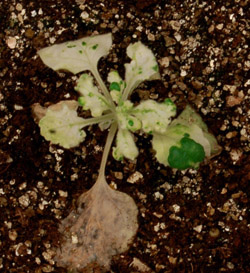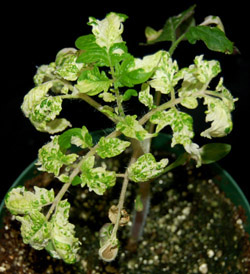A subscription to JoVE is required to view this content. Sign in or start your free trial.
Method Article
Virus-induced Gene Silencing (VIGS) in Nicotiana benthamiana and Tomato
Summary
Description of a virus-induced gene silencing (VIGS) method for knock-down of gene expression in Nicotiana benthamiana and tomato.
Abstract
RNA interference (RNAi) is a highly specific gene-silencing phenomenon triggered by dsRNA1. This silencing mechanism uses two major classes of RNA regulators: microRNAs, which are produced from non-protein coding genes and short interfering RNAs (siRNAs). Plants use RNAi to control transposons and to exert tight control over developmental processes such as flower organ formation and leaf development2,3,4. Plants also use RNAi to defend themselves against infection by viruses. Consequently, many viruses have evolved suppressors of gene silencing to allow their successful colonization of their host5.
Virus-induced gene silencing (VIGS) is a method that takes advantage of the plant RNAi-mediated antiviral defense mechanism. In plants infected with unmodified viruses the mechanism is specifically targeted against the viral genome. However, with virus vectors carrying sequences derived from host genes, the process can be additionally targeted against the corresponding host mRNAs. VIGS has been adapted for high-throughput functional genomics in plants by using the plant pathogen Agrobacterium tumefaciens to deliver, via its Ti plasmid, a recombinant virus carrying the entire or part of the gene sequence targeted for silencing. Systemic virus spread and the endogenous plant RNAi machinery take care of the rest. dsRNAs corresponding to the target gene are produced and then cleaved by the ribonuclease Dicer into siRNAs of 21 to 24 nucleotides in length. These siRNAs ultimately guide the RNA-induced silencing complex (RISC) to degrade the target transcript2.
Different vectors have been employed in VIGS and one of the most frequently used is based on tobacco rattle virus (TRV). TRV is a bipartite virus and, as such, two different A. tumefaciens strains are used for VIGS. One carries pTRV1, which encodes the replication and movement viral functions while the other, pTRV2, harbors the coat protein and the sequence used for VIGS6,7. Inoculation of Nicotiana benthamiana and tomato seedlings with a mixture of both strains results in gene silencing. Silencing of the endogenous phytoene desaturase (PDS) gene, which causes photobleaching, is used as a control for VIGS efficiency. It should be noted, however, that silencing in tomato is usually less efficient than in N. benthamiana. RNA transcript abundance of the gene of interest should always be measured to ensure that the target gene has efficiently been down-regulated. Nevertheless, heterologous gene sequences from N. benthamiana can be used to silence their respective orthologs in tomato and vice versa8.
Protocol
Part 1: Plant material
N. benthamiana plants used for silencing should be around 2 ½ weeks old which is the time when the cotyledons and the first 2 - 4 true leaves have emerged. Tomato (Solanum lycopersicum) plants are used 7 - 8 days post emergence, when the true leaves have not yet appeared.
Part 2: VIGS
DAY 1
- For each experiment, Agrobacterium tumefaciens harboring pTRV1, pTRV2, pTRV2-PDS and pTRV2-host target gene are grown on LB agar plates supplemented with 50 μg/mL of kanamycin and 100 μg/mL of rifampicin. The kanamycin selects for the pTRV plasmid while the rifampicin does so for the Agrobacterium. Incubate the plate at 30° C for 2 days.
Silencing of PDS will cause the plants to photobleach and is used as a silencing efficiency control. Also, the genes to be downregulated must be cloned into a pTRV2 vector. There is a Gateway compatible pTRV2 vector which may facilitate the cloning and is described by Liu et al. (2002).
DAY 3
- Inoculate a 2 - 3 mL liquid culture of LB with the above mentioned antibiotics for each of the strains. Incubate by shaking at 30 °C for 16 - 18 hours and 200 r.p.m.
DAY 4
- Inoculate a 1 : 25 dilution of the primary culture into a secondary liquid Induction Media (IM) IM culture with kanamycin, rifampicin and 200 μM acetosyringone (Tables 1, 2 and 3). The acetosyringone is used as an inducer of the vir genes of Agrobacterium which are required for T-DNA transfer into the plant9 while the IM mimics the environment this pathogen encounters in the host apoplast. Incubate by shaking at 30 °C for 20 – 24 hours and 200 r.p.m.
DAY 5
- Harvest the cells by centrifugating for 10 minutes at 3000 x g. Resuspend in the same volume that the original culture had with 10 mM MgCl2, 10 mM MES pH 5.5. Cells may be gently vortexed to resuspend them.
- Centrifugue the cells again for 10 minutes at 3000 x g. Resuspend in half the volume of the original culture with 10 mM MgCl2, 10 mM MES pH 5.5.
- Prepare a bacterial suspension with an O.D.600 of 0.3 for each bacterial culture. Add acetosyringone to a final concentration of 400 μM to the pTRV1 culture.
- Mix the cultures containing the pTRV1 and the pTRV2 (or the pTRV2 containing the gene of interest) in a 1 to 1 ratio. Also include a pTRV2-PDS control. Please note that the final acetosyringone concentration is now 200 μM and that each culture is at an O.D.600 of 0.15.
- Label the seedlings to be infiltrated with the gene to be silenced and the date of the experiment.
- Poke a hole into each leaf to be infiltrated with a needle. Use a 1 mL needless syringe to infiltrate the bacterial suspension into the seedlings. For tomato, infiltrate both cotyledons while for N. benthamiana, infiltrate the biggest two true leaves. Five mL of each bacterial mixture should be enough to infiltrate 15 N. benthamiana and 25 tomato seedlings. Avoid cross-contamination by changing gloves between infiltrations and by not watering the plants until the next day after the inoculation.
- The plants are kept at 20 - 22 °C in a growth chamber with a 16 hour day length and 50 % RH for at least 3 ½ weeks before they may be used for assays.
Part 3: Representative results
Figure 1 shows a representative experiment with N. benthamiana and tomato plants silenced for PDS. Plants show the characteristic photobleaching phenotype observed in plants with diminished amounts of carotenoids. For the PDS-silenced control plants, photobleaching starts to be seen as soon as 1 ½ weeks after infiltration.


Figure 1. Silencing of the PDS control gene causes photobleaching in N. benthamiana (A) and tomato (B) plants. Photographs were taken 3 ½ weeks after silencing.
Table 1. Preparation of Induction Medium (IM).
| 400 mL | distilled H2O |
| 4.88 g | MES (2-(4 morpholino)-ethane sulfonic acid) |
| 2.5 g | Glucose |
| 0.12 g | NaH2PO4 |
Bring to a final volume of 475 mL with dH2O and adjust the pH to 5.6. Autoclave. After the medium has cooled down, add 25 mL of 20X AB salts.
Table 2. Preparation of AB salts.
| 20 g | NH4Cl |
| 6 g | MgSO4·7H2O |
| 3 g | KCl |
| 0.2 g | CaCl2 |
| 0.05 g | FeSO4·7H2O |
Bring to a final volume of 1 liter with distilled water. Autoclave. Be aware that AB salts precipitate as an orange powder. Just mix them well by swirling before their use.
Table 3. Preparation of 200 mM Acetosyringone. Please note that acetosyringone should be prepared the day it will be used.
| 19.6 mg | Acetosyringone (3’, 5’-Dimethoxy-4’-hydroxyacetophenone) |
| 500 μL | DMSO (Dimethyl sulfoxide) |
Discussion
Virus-induced gene silencing is a method that allows rapid reverse genetic screens. It avoids the generation of T-DNA or transposon mediated gene knock-outs, which are only available in certain plants like Arabidopsis and maize. It also circumvents the time consuming process of plant transformation and allows the targeting of multiple genes at the same time, provided that they have sufficient homology10 or that different host target sequences are arranged in tandem in the silencing vector6, 11
Acknowledgements
We thank Dr. Patricia Manosalva for her valuable insights on the manuscript. Funding was provided by the National Science Foundation Plant Genome Program, award number DBI-0605059.
References
- Voinnet, O. RNA silencing as a plant immune system against viruses. Trends Genet. 17, 449-459 (2001).
- Carrington, J. C., Ambros, V. Role of microRNAs in plant and animal development. Science. 301, 336-338 (2003).
- Chen, X. A microRNA as a translational repressor of APETALA2 in Arabidopsis flower development. Science. 303, 2022-2025 (2004).
- Palatnik, J. F. Control of leaf morphogenesis by microRNAs. Nature. 425, 257-263 (2003).
- Brigneti, G. Viral pathogenicity determinants are suppressors of transgene silencing in Nicotiana benthamiana. EMBO J. 17, 6739-6746 (1998).
- Liu, Y., Schiff, M., Dinesh-Kumar, S. P. Virus-induced gene silencing in tomato. Plant Journal. 31, 777-786 (2002).
- MacFarlane, S. A. Molecular biology of the tobraviruses. J. Gen. Virol. 80, 2799-2807 (1999).
- Senthil-Kumar, M. A systematic study to determine the extent of gene silencing in Nicotiana benthamiana and other Solanaceae species when heterologous gene sequences are used for virus-induced gene silencing. New Phytol. 176, 782-791 (2007).
- McCullen, C. A., Binns, A. N. Agrobacterium tumefaciens and plant cell interactions and activities required for interkingdom macromolecular transfer. Annu. Rev. Cell Dev. Biol. 22, 101-127 (2006).
- Rosebrock, T. R. A bacterial E3 ubiquitin ligase targets a host protein kinase to disrupt plant immunity. Nature. 448, 370-374 (2007).
- Miki, D., Itoh, R., Shimamoto, K. RNA silencing of single and multiple members in a gene family of rice. Plant Physiol. 138, 1903-1913 (2005).
- Voinnet, O. Use, tolerance and avoidance of amplified RNA silencing by plants. Trends Plant Sci. 13, 317-328 (2008).
- Ekengren, S. K., Liu, Y., Schiff, M., Kumar-Dinesh, S. P., Martin, G. B. Two MAPK cascades, NPR1, and TGA transcription factors play a role in Pto-mediated disease resistance in tomato. Plant J. 36, 905-917 (2003).
- Liu, E., Page, J. E. Optimized cDNA libraries for virus-induced gene silencing (VIGS) using tobacco rattle virus. Plant. Methods. 4, 5-5 (2008).
Reprints and Permissions
Request permission to reuse the text or figures of this JoVE article
Request PermissionExplore More Articles
This article has been published
Video Coming Soon
Copyright © 2025 MyJoVE Corporation. All rights reserved